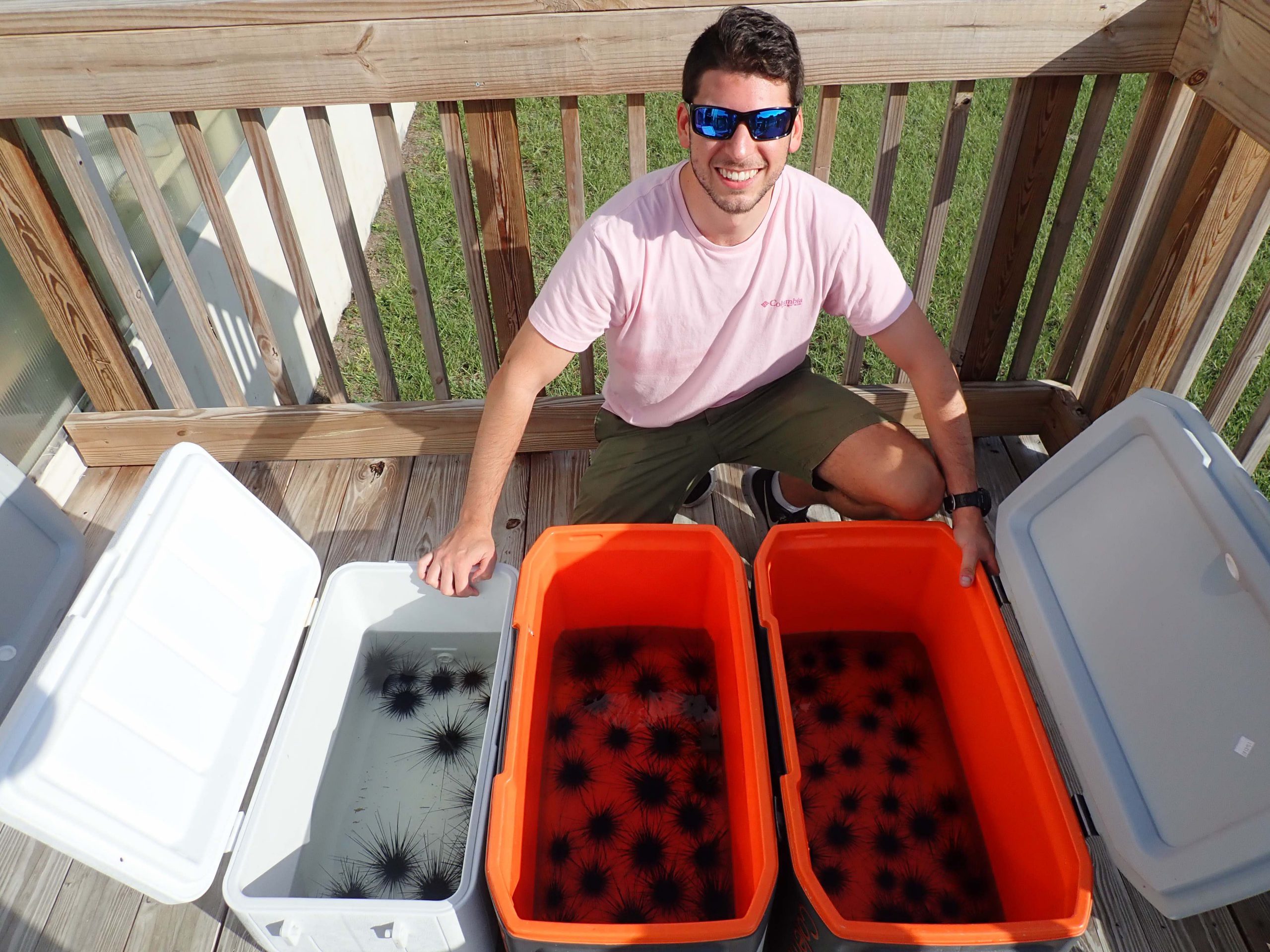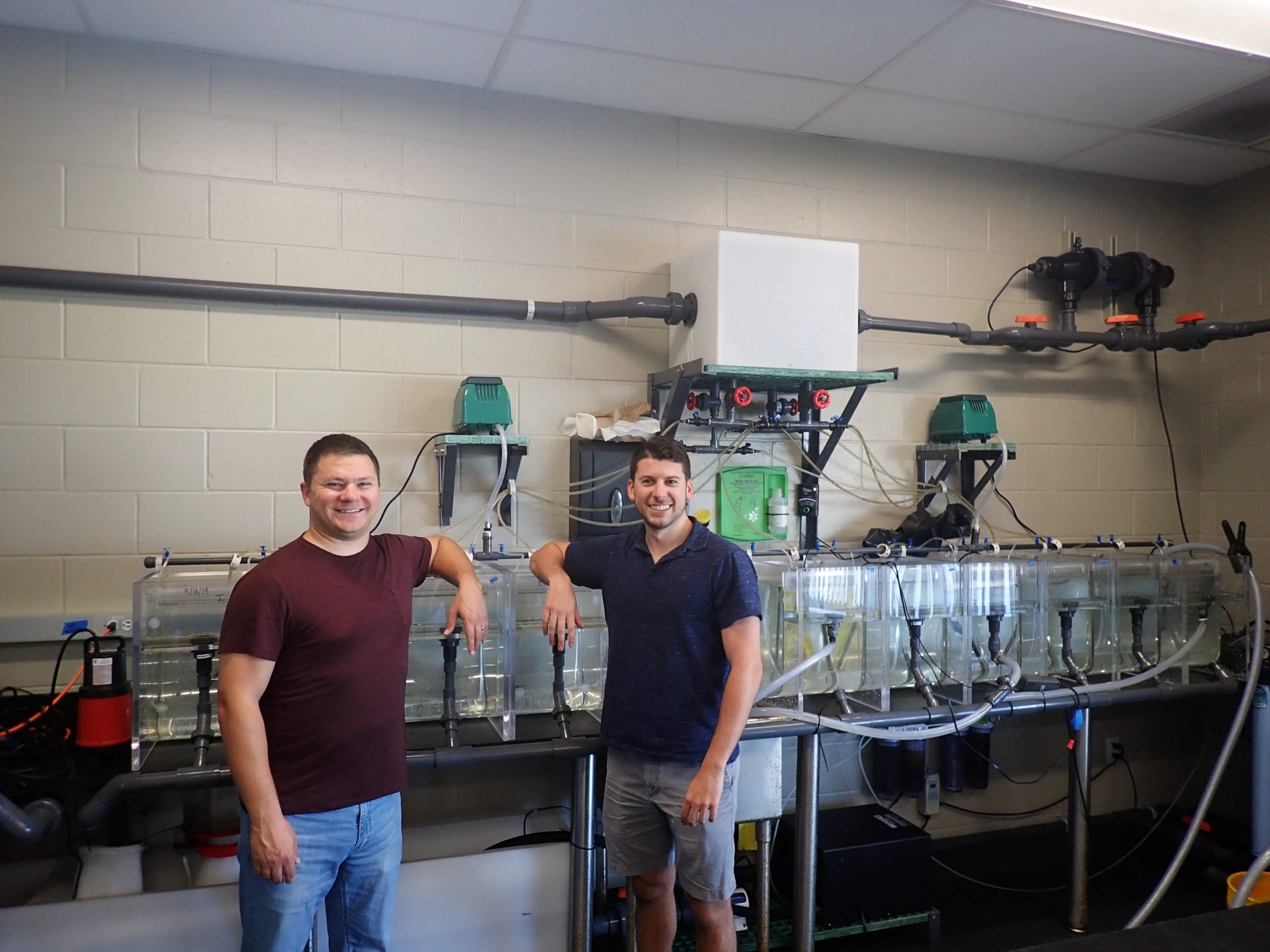Aaron Pilnick, a graduate research assistant with the School of Natural Resources and Environment (SNRE), is researching how to culture an ecologically vital species of sea urchin, the long-spined sea urchin Diadema antillarum. Aaron is advised by SFRC‘s Dr. Josh Patterson, based in Apollo Beach, FL.

“Restoring diminished Diadema populations is a crucial to reviving our hurting coral reefs. Along with other graduate students in Dr. Patterson’s lab, I am based out of the Florida Aquarium Center for Conservation (CFC) in the Tampa Bay area. The CFC is a 20-acre facility situated within a larger 400-acre area of conservation land in Apollo Beach, FL, owned by the Tampa Electric Company. The CFC represents a really unique partnership where the Florida Aquarium, The Florida Fish and Wildlife Conservation Commission, and UF all work on-site together to achieve conservation, research, and outreach objectives.
Specifically, the Florida Aquarium built and now operates a sea turtle rehabilitation center and a land-based coral nursery, with coral greenhouses which they call “living arks,” to house critically endangered species of coral. The living arks are akin to seed banks where we can preserve invaluable genetic diversity for the future in the event of species extinction. Many of these species are in danger of extinction in the United States’ single major coral reef system, the Florida Reef Tract. As we speak, reefs are disappearing rapidly in the Florida Reef Tract due to disease, global climate change, pollution, and other stressors. At the CFC, The Florida Aquarium is generating technologies that will enable us to sexually propagate at-risk corals and restore dead and dying coral reefs : https://www.cnn.com/2019/08/21/us/historic-coral-discovery-scn-trnd/index.html
However, there are problems that need to be solved before we can effectively restore coral reefs in the Florida Reef Tract and greater Caribbean. One of the major events that contributed to the ongoing decline of our reefs occurred in the early 1980’s when the ecologically important long-spined sea urchin, Diadema antillarum, was nearly wiped out due to a mysterious disease. We estimated that nearly 97% of all Diadema on Caribbean reefs died within two weeks of being exposed to this disease. The negative consequences of this event for coral reefs were huge. As one of the primary reef-grazing herbivores, Diadema are responsible for consuming large fleshy macroalgae; when they disappeared, this algae effectively began to smother our reefs and prevent coral recruitment and growth. Unfortunately, Diadema populations have not recovered substantially since the 1980’s, and many Caribbean coral reefs have transitioned from hard coral dominated to macroalgae dominated ecosystems. One major component of larger coral reef restoration strategies involves restoring this lost herbivory with sexually propagated Diadema. A critical first step in this process requires the ability to produce Diadema from gametes in a laboratory.

My research, which started in January 2018, focuses on figuring out how to culture Diadema so that we can begin to experiment with restocking and population enhancement on the reef. Research into Diadema aquaculture has been occurring for almost 30 years but has been met with partial success due to the extremely difficult nature of this process. In nature, sea urchins broadcast their gametes into the water column, and externally fertilized embryos develop into microscopic larvae (Figure 1) that travel throughout the ocean feeding on phytoplankton. When the larvae find an optimal environment, such as a reef, they settle and metamorphose/transform into juvenile urchins. Replicating this process in the lab is very difficult because Diadema larvae are physically fragile, very sensitive to pollution in the water, and have a very long developmental period of 40-plus days.

With funding from the Florida Aquarium, I designed and built a novel aquaculture system (Figure 2) at the CFC to tackle some of the major questions impeding our ability to reliably culture Diadema. Thankfully I was qualified for this project because of my prior work experience at the National Aquarium in Baltimore, MD, where I helped to design and maintain life support systems on giant fish tanks up to 350,000-gallons. The culture process consists of spawning and collecting gametes from both male and female adult Diadema (Figure 3 & 4), moving the gametes up to the aquaculture system, and growing the larvae over the 40-plus day developmental period.

After working on this project for over a year and consistently experiencing culture crashes (sometimes as late as 35 days into an experiment), we finally succeeded in culturing Diadema in June 2019 (figure 5-9). This was a huge step forward for the research program, as we are now one of the the only institutions capable of culturing Diadema. We also generated experimental data including appropriate phytoplankton diets, water quality, larval densities, and developmental timelines that we are in the process of publishing. Next steps in the research will examine factors to improve efficiencies in the culture process, with the ultimate goal to scale up production for restocking on the reefs. With this work, we are getting one step closer viably restoring Diadema populations.
In addition to my advisor Dr. Patterson, I have been mentored through this project by the legendary Martin Moe, a retired marine biologist whose work has been foundational in the aquaculture community. He was the first to figure out how to culture many different marine species, kickstarted various aquaculture industry practices, and has authored many books including how-to guides for marine aquariums. My father actually bought one of his books before I was born and so it is an incredible honor to now be working with Martin. He spent over fifteen years figuring out the basics with Diadema culture and now provides us with guidance along the way. https://reefbuilders.com/2015/01/29/martin-moe-diadema-urchin-video/
This project is important to me for many reasons. I grew up fishing and diving in the Florida Keys (and even taught scuba diving as an instructor in Key Largo), and now I feel compelled to try and fix some of the problems we are dealing with there so that future generations are not robbed of similar experiences. I also know how monetarily important these ecosystems are to Florida’s economy, and hopefully this research will provide positive value to the state. Thankfully both UF and our partners at the Florida Aquarium recognize this value and have fully supported the project along the way.”






 0
0
